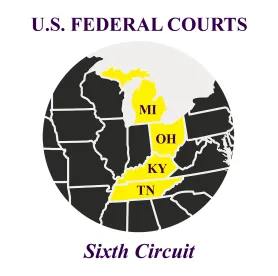In a highly anticipated decision, the U.S. Court of Appeals for the Sixth Circuit has ruled it will not use the lenient, two-step procedure in deciding whether to authorize sending notice of a collective action to other workers under the Fair Labor Standards Act (FLSA). Clark v. A&L Homecare and Training Center, LLC, Nos. 22-3101 & 22-3102 (May 19, 2023).
Adopting a new approach, the Sixth Circuit will require plaintiffs to demonstrate a “strong likelihood” that other employees are similarly situated before the court-approved notice may be sent to employees who are in fact similarly situated.
The Sixth Circuit has jurisdiction over Kentucky, Michigan, Ohio, and Tennessee.
Similarly Situated
The FLSA allows plaintiffs to pursue claims as a collective action if they can show there are other “similarly situated” employees who allegedly suffered the same conduct giving rise to a violation of the law.
The procedural question is how rigorous a showing of similarity is required by plaintiffs at the early stage of a litigation for them to proceed on a collective basis and for the court to authorize sending written notice of the lawsuit to potential plaintiffs who may choose to opt-in to the case.
Lusardi Framework
For years, many federal courts have applied the two-stage conditional certification approach introduced in Lusardi v. Xerox Corp., 99 F.R.D. 89 (D.N.J. 1983). Under this framework, courts grant conditional certification, and authorize notice of the suit, based on a minimal showing that potential plaintiffs are similarly situated. A plaintiff’s burden at this stage often is modest: the first step generally involves only an analysis of a plaintiff’s complaint allegations. The low bar means plaintiffs routinely obtain conditional certification with minimal or no pre-trial discovery.
While the Sixth Circuit had never formally adopted Lusardi, district courts within the circuit generally had followed its framework.
In Clark, a divided circuit panel expressly rejected the framework and its lenient standard for determining plaintiffs are similarly situated for purposes of facilitating notice of the suit.
“Strong Likelihood”
Citing concerns that facilitating notice to plaintiffs who are not similarly situated is tantamount to soliciting lawsuits from those employees, the Sixth Circuit held that district courts should require plaintiffs to demonstrate a “strong likelihood” that other employees are similarly situated. This standard will “confine the issuance of court-approved notice, to the extent practicable, to employees who are in fact similarly situated; and it would strike the same balance that courts have long struck in analogous circumstances,” the appeals court wrote.
The appeals court likened its new approach to the standard applied by courts when making the “provisional” determination whether to grant a preliminary injunction. The panel acknowledged that, under the new framework, the statute-of-limitations period continues to run while the parties engage in pre-trial discovery over whether potential plaintiffs should get notice of the lawsuit. Therefore, the court instructed district courts to “expedite” the determination of whether potential opt-ins are similarly situated.
Notice to Employees With Arbitration Agreements
The plaintiffs also filed a cross-appeal in this case challenging the district court’s refusal to send notice to employees who signed arbitration agreements with the defendant-employer. The plaintiffs argued the court should not presume that the agreements were enforceable and that their participation in the lawsuit was therefore foreclosed.
However, the appeals court explained, that some employees had signed arbitration agreements was just one of the factors to be weighed in determining whether there is a strong likelihood the potential plaintiffs are similarly situated. (On this point, the Sixth Circuit deepened a split among the federal circuits as to whether employees with arbitration agreements should be automatically precluded from receiving notice of a pending collective action.)
Domino Effect?
The Sixth Circuit is the second federal court of appeals to reject the familiar two-step framework for conditional certification. The Fifth Circuit, in Swales v. KLLM Transport Services, LLC, 985 F.3d 430 (2021), was the first to reject conditional certification, and the impact on certification decisions in that circuit was immediate. Swales also prompted calls for courts outside the circuit to revisit the lenient conditional certification commonly used.






 />i
/>i

